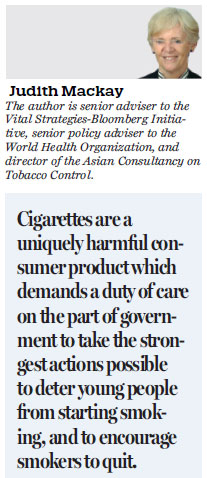Big cigarette warnings needed to cut deaths
Updated: 2017-05-12 09:34
(HK Edition)
|
|||||||
Judith Mackay dismisses tobacco industry's arguments that larger images of smoking's dangers will drive illicit trade
What should a government do, faced with 7,000 preventable deaths in Hong Kong brought by the most dangerous consumer product on the market?
Every thoughtful and sensible citizen would answer that government has a duty of care to warn of the danger of that product, and take preventive action such as legislation.
Yet headlines screamed last week that vendors in Hong Kong threaten protests if larger warnings are printed on cigarette packs.
Apparently their concern is that if warnings are increased from 50 percent of a pack's surface - imposed since 2007 - to 85 percent as proposed, smokers will turn to illicit tobacco products, and this could hit their business.
Their fears are misinformed and misguided. There is simply no evidence that enlarging warning labels leads to smuggling.

Rob Cunningham of the Canadian Cancer Society, who has published a widely respected authoritative global review of the 105 jurisdictions in the world with graphic warnings, says the illicit trade argument is "nonsense"; even the further step of plain packaging will not cause counterfeiting or contraband.
The Hong Kong Food and Health Bureau also cited World Health Organization findings that pictorial warnings would not increase illicit trade.
For example, when Canada increased pack warnings from 50 percent to 75 percent in 2012, the measure did not cause increased contraband.
The tobacco industry has challenged effective legislation for introducing or enlarging pack warnings and plain packaging around the world but these challenges have all been dismissed, for example, in Australia, the United Kingdom, France, the European Union and Uruguay.
The tobacco industry and its allies are engaging in misinformation, typical of the industry's approach over decades. Remember that this is an industry that has had previous campaigns saying smoking did not cause lung cancer, and second-hand smoke is not harmful.
The tobacco industry opposes the bill because graphic warnings rate among the top three most effective measures to reduce smoking levels. Well-designed pack warnings are a highly cost-effective means to increase awareness of the health effects and to reduce tobacco use.
Hundreds of studies on the effectiveness of warnings have reached five conclusions.
Firstly large graphic warnings attract and hold attention better, increase knowledge about risks of smoking and exposure to second-hand smoke, discourage non-smokers from starting to smoke and promote quitting.
Secondly graphic warnings generate more quit attempts, increase intentions to quit and lead to more forgoing of cigarettes, and more successful attempts to quit smoking.
Thirdly graphic warning labels can be understood by low-literacy audiences and children - two vulnerable population groups. In Hong Kong they can be understood by all nationalities.
Fourthly, prolonged exposure to the same warnings (as in Hong Kong) decreases their effectiveness (as with all messaging), so they need to be changed.
Fifthly larger warnings, as one would expect by common sense, are more noticeable and lead to increased thinking about risks of smoking, increased thinking about quitting, and cut the number of cigarettes taken.
The industry and its allies also complain there had not been sufficient public (and industry) consultation. This is simply not true. The proposal was first submitted by the government in 2015 and there have been endless documents, meetings including opportunities to make written and oral submissions to the Legislative Council. The Food and Health Bureau has even kept the trade posted on the progress and the implementation of the proposal.
Since Canada introduced graphic warnings in 2001, more than 100 countries and jurisdictions worldwide now require pictorial warnings. This represents a landmark global public health achievement.
Hong Kong has slipped since it was the 12th jurisdiction to introduce graphic warnings in 2007; all the other 11 jurisdictions have upgraded their warnings since then - Uruguay seven times! And Hong Kong's warnings now rank behind India, Thailand, Laos, Myanmar, Sri Lanka, some African countries and even Fiji and Vanuatu.
There are about 7,000 deaths every year from smoking in Hong Kong. Cigarettes are a uniquely harmful consumer product which demands a duty of care on the part of government to take the strongest actions possible to deter young people from starting smoking, and to encourage smokers to quit.
(HK Edition 05/12/2017 page1)